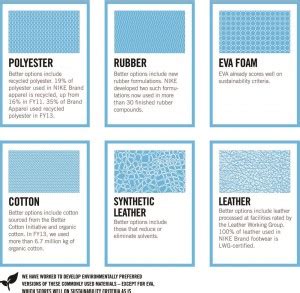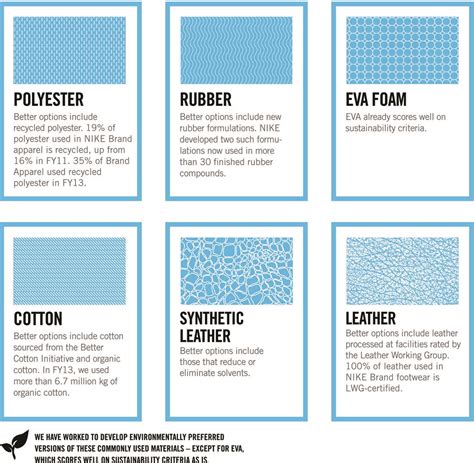nike raw materials We’re doubling down on pre-competitive collaborations with suppliers, competitors, NGOs, and governments to shift the status quo in the global supply chain. $15K+
0 · who supplies nike with materials
1 · what materials do nike use
2 · raw materials in nike shoes
3 · nike raw materials supply chain
4 · nike raw material suppliers
5 · nike air force 1 materials
6 · how are nike products made
7 · does nike use recycled materials
New watches 2022 Oyster Perpetual Day-Date 40 The Day-Date has always epitomized prestige and innovation. Exclusively made from precious metals, it was the first calendar wristwatch to indicate, in addition to the date, the day of the week spelt out in full in a window on the dial. The Day-Date 40 in platinum is now available
who supplies nike with materials
From sweat-wicking fabrics to the bouncy foam under your feet, materials make up more than 70% of any product’s footprint. By inventing more efficient materials and reusing existing plastics, yarns and textiles, we’re making big strides on our journey to zero carbon and zero waste.We’re doubling down on pre-competitive collaborations with suppliers, competitors, NGOs, and governments to shift the status quo in the global supply chain. Nike uses many materials to make all their products but there are only six main materials that make up the majority of all their products mass. First the polyester, 19 percent of the polyester Nike uses is recycled. Nike helped .Most raw materials in NIKE’s supply chain are sourced in the manufacturing host country by independent contractors. Overseas manufacturing of products features in the strategies of rivals.
We’re doubling down on pre-competitive collaborations with suppliers, competitors, NGOs, and governments to shift the status quo in the global supply chain. The first step in the supply chain at Nike is the raw material suppliers or producers. Nike has raw material suppliers that source the raw materials that Nike uses in .
burberry jumpsuit womens
This site is a tool to learn about the independent factories and material suppliers used to manufacture NIKE products - including the name and location of each factory and the types of . In 2019, Nike sourced 93% of its products and materials from sustainably run factories, well on its way to its target of 100% by the end of 2020. It has also reduced the number of factories in its supply chain that inflict .Most Nike shoes use a mix of leather, fabric, foam, and rubber. The Nike classics and deluxe model basketball shoes will have real leather parts. Nike running shoes and modern performance baseball shoes are generally made . According to Nike, the company reduced its freshwater use by 6.7% per kilogram in 2021 of material for its textile dyeing and finishing factories. “We’ve done good work in the water space.

Nike Manufacturing Map: Transparency is fundamental to NIKE, Inc. business and our approach to sustainability. This site is a tool to learn about the independent factories and material suppliers used to manufacture NIKE products - including the name and location of each factory and the types of products they produce.The use of more sustainable materials used in Nike's apparel increased from 41 percent to 59 percent in the 2020 financial year. In 2015, the use of more sustainable materials used in apparel was .
Nike Air. Since 2008, all Nike Air soles are composed of at least 50% recycled manufacturing waste. As of 2020, all of Nike's AirMI facilities in North America are powered by 100% renewable wind energy. We reuse more than 90% of the waste from materials used for our Air soles to make new, innovative cushioning systems. Light on your feet. Light .NIKE’s independent contractors and suppliers buy raw materials in bulk for the manufacturing of our footwear, apparel, and equipment products. Most raw materials are available and purchased by those independent contractors and suppliers in the countries where manufacturing takes place.Flyleather is Nike’s most sustainable engineered leather material ever, made from at least 50% leather fiber. It’s created using leather manufacturing scraps that would otherwise go to landfill. . The textile is locally sourced and aims to minimize the demand for new raw materials as well as diverting it from unnecessary incineration or . Today, Nike takes an ambitious approach to managing the impact of its supply chain that is as pioneering as its initial transition to 100% outsourced manufacturing was over 30 years ago. In 2019, Nike sourced 93% of its products and materials from sustainably run factories, well on its way to its target of 100% by the end of 2020.
In 2024, Nike, a global leader in sportswear and athletic footwear, encountered a significant crisis when its global supply chain was severely disrupted. . and the fluctuating availability of raw materials. As a result, Nike faced delays in the production and delivery of its products, leading to stock shortages in stores and significant .
With its management systems and processes, Nike's footwear manages to produce and sell hundreds of millions of its products through its management and complex supply chain. What Is Manufacturing? Manufacturing is the process of creating different products from raw materials, either by people or through machines.
cu Step 2: After the designs have been tested and approved the raw materials are purchased for production of the shoe. This is a map of the countries that produce the different materials needed to assemble the Nike shoes. There are 4 main materials used including polyester, cotton, eva foam, and rubber.Nike Air. Since 2008, all Nike Air soles are composed of at least 50% recycled manufacturing waste. As of 2020, all of Nike's AirMI facilities in North America are powered by 100% renewable wind energy. We reuse more than 90% of the waste from materials used for our Air soles to make new, innovative cushioning systems. Light on your feet. Light .
what materials do nike use
Nike footwear is made in 122 factories across 12 countries, with half of the shoes made in Vietnam. . Raw materials must then be transported to factories, with the resulting products being transported to ports for shipping. This makes Nike highly dependent on southeast Asia for its products, and a major disruption (e.g., a tsunami) could .Nike Forward is an all-new material made from ultra-thin, needle-punched layers. It's super soft, incredibly warm and absurdly lightweight. Designed with sustainability in mind, our inaugural collection has a reduced carbon footprint of 75% on average when .
Therefore, Nike relies on a vast array of raw materials and chemical components as inputs for the production process, making Nike vulnerable to climate change in two ways: 1.Supply shortages and price increases of raw materials due to natural disasters or changes in weather pattern Raw Materials – Nike uses six main raw materials in its products (see below) each of which requires enormous amounts of resources (e.g., water) and energy (emitting greenhouse gases) to produce. (3) In one pair of shoes, .Raw Materials; Transport; Work Cited; Manufacturing Process. Almost all Nike shoes are manufactured outside of the United States. The leading manufacturer of Nike shoes is China and Vietnam each accounting for 36% of the total .The main raw materials that Nike uses are leather, rubber, and textiles. Nike works with its suppliers to ensure that they meet its high standards for quality and sustainability. Nike’s sourcing process begins with identifying potential .
Nike Air. Since 2008, all Nike Air soles are composed of at least 50% recycled manufacturing waste. As of 2020, all of Nike's AirMI facilities in North America are powered by 100% renewable wind energy. We reuse more than 90% of the waste from materials used for our Air soles to make new, innovative cushioning systems. Light on your feet. Light .The first step involves sourcing all the raw materials required for the production of the shoes. These raw materials are sourced from different parts of the world and shipped to factories worldwide. The Nike vendors have to work with these raw materials only to manufacture Nike goods. This ensures that the standard quality of Nike shoes is .
Find Running At Least 20% Sustainable Material Shoes at Nike.com. Free delivery and returns.
Nike Forward is an all-new material made from ultra-thin, needle-punched layers. It's super soft, incredibly warm and absurdly lightweight. Designed with sustainability in mind, our inaugural collection has a reduced carbon footprint of 75% on average when . Nike’s Raw Materials & Sustainable Material Innovations Flyknit, Nike’s site. Nike’s material innovations have taken different shapes over the years, the latest being the Space Hippie, a shoe made of waste as feedstock (50% by weight). The upper is made from post-consumer waste and the sole from industrial waste.
The processing step transforms the separated materials into Nike Grind. Rubber, foam, fiber, leather, and textile blends are ground into granules. This process is not just about breaking down materials but also about creating a new, high-quality raw material that meets Nike’s standards for performance and sustainability. Granules Nike must also manage the risk of disruptions to its supply chain. This can include things like natural disasters, political instability, and supplier bankruptcies. Nike must have plans in place to deal with disruptions when they occur. Finally, Nike must continuously adapt its supply chain to changing market conditions.The materials used to make Nike shoes also play a big role in the manufacturing process. For instance, synthetic materials like leather, suede, rubber, and mesh are all used to construct Nike shoes. . From the sourcing of the raw materials to the final inspection of the shoes, each step is carefully monitored to ensure the highest quality and .
raw materials in nike shoes
Nike uses scraps as it’s raw material and the scraps of the scraps that are used to make the shoe are repurposed to make more shoes. As a result, the shoes establish a healthy cycle of material sustainability. The Nike Space Hippie shoes use recycled materials that require the least amount of energy to process as well. Compared to materials .
The current study analyses Nike's journey to responsible sourcing in the global market. The study discusses how the problem of Nike's sweatshop supply chain emerged and how the company reacted.
nike raw materials supply chain

$4,700.00
nike raw materials|raw materials in nike shoes

























